Structured data at scale for B2B and enterprise SEO
Learn how to implement, automate, and manage structured data across thousands of enterprise pages to boost SEO performance, visibility, and rich results.
Structured data is code you can manually or automatically add to your site. This code makes additional context available to search engines about the page’s content, making it easier for them to understand and rank your pages. It can also help your content appear in features like knowledge graphs on search engine result pages (SERPs), boosting your website’s visibility.
While it can seem intimidating, structured data is more straightforward than you think.
Sometimes, you can manually copy and paste a snippet of structured data onto your site and earn a new SERP feature within a day or two.
That said, manually adding structured data to hundreds of pages on a large enterprise site can be incredibly tedious. Instead, you’ll want to use tools and rules to streamline the process through automation.
This article covers the role of structured data on B2B websites, why you should be using it, the challenges involved, how to resolve them, and tools that make light work of structured data—even on larger websites.
Structured data versus schema (and how they work together)
Before we begin, let’s clarify the differences between structured data and schema. The terms are often used interchangeably, but they’re not the same.

Simply put: all schema is structured data, but not all structured data is schema.
Schema explained
Schema.org defines types and properties and how they’re used to structure data on the web.
When structuring data for SEO purposes, we use schema.org, which provides a standardized framework search engines can easily interpret.
For example:
- Types like
“Product,”“Article,”or"Event" - Properties like
“Name,”“Author,”or“datePublished”
A Type could be a page type such as an article, for example. That article then has Properties that belong within it, such as an author’s name and the date the content was published.
Schema provides the rules and framework that allow structured data to be understood by search engines.
Structured data explained
Structured data refers to data organized in a particular format. When implementing structured data on a website, it’s best to use a format that is easy for search engines to read, such as JSON-LD, Microdata, or RDFa.
However, structured data isn’t just used for search engines. It encompasses broad uses, such as spreadsheets and databases. Wherever data needs to be organized, you’ll find structured data.
The SEO and business case for structured data
SEO is the primary motivation for including structured data on a website. Structured data is housed in the website’s code and isn’t visible to users (unless they know how to view and understand the code, of course).
Here are some of the reasons why structured data is helpful for B2B websites.
Improved SERP visibility (earning rich snippets)
Structured data plays a role in SERP visibility. The additional context provided by structured data and schema to search engines makes it possible for search engines to understand how to present your data in rich snippets, which are enhanced search results such as images, rating stars, prices, and knowledge graphs.
Structured data does not guarantee that Google will display your content in rich snippets.
For B2B websites, schema and structured data are commonly used to influence:
- Knowledge panels
- Image results
- Review snippets
- Events
- Jobs
- FAQs
- And so much more
Further reading: Google’s document of supported structured data markup
Increased clicks and engagement metrics
Generally, with enhanced visibility in SERPs comes more clicks.
Studies show that review stars in SERPs increase clicks by 35%.
As part of the study to know how Google star ratings impact the buyer’s clicking decision, a group of users was encouraged to view search engine results in Google and click on any link keeping the following things in mind:
- Why did you click on that particular link?
- Which brands have you previously used for the service?
- What’s the most important factor you consider when making that particular choice?
Based on all this information, results were evaluated, and it was found that Google stars lead to a 35% boost in click-through rate (CTR)!
Here’s what review stars look like on Google’s SERPs:

Stars are more likely to appear in SERPs after schema and structured data are applied.
Proving your Experience, Expertise, Authority, and Trust (E-E-A-T)
Structured data builds Experience, Expertise, Authority, and Trust (E-E-A-T) because you can use structured data to inform Google about the experience and expertise of individual people or companies.
Structured data allows you to draw the full picture of a person’s or company’s digital presence through entities.
Entities are recognizable Types or Properties, such as a “person,” “organization,” “place,” or “concept.”
Refer to schema.org for entities that Google recognizes.
Below is an example of Person Type schema. Schema.org details all the properties that belong to a Type and a description.
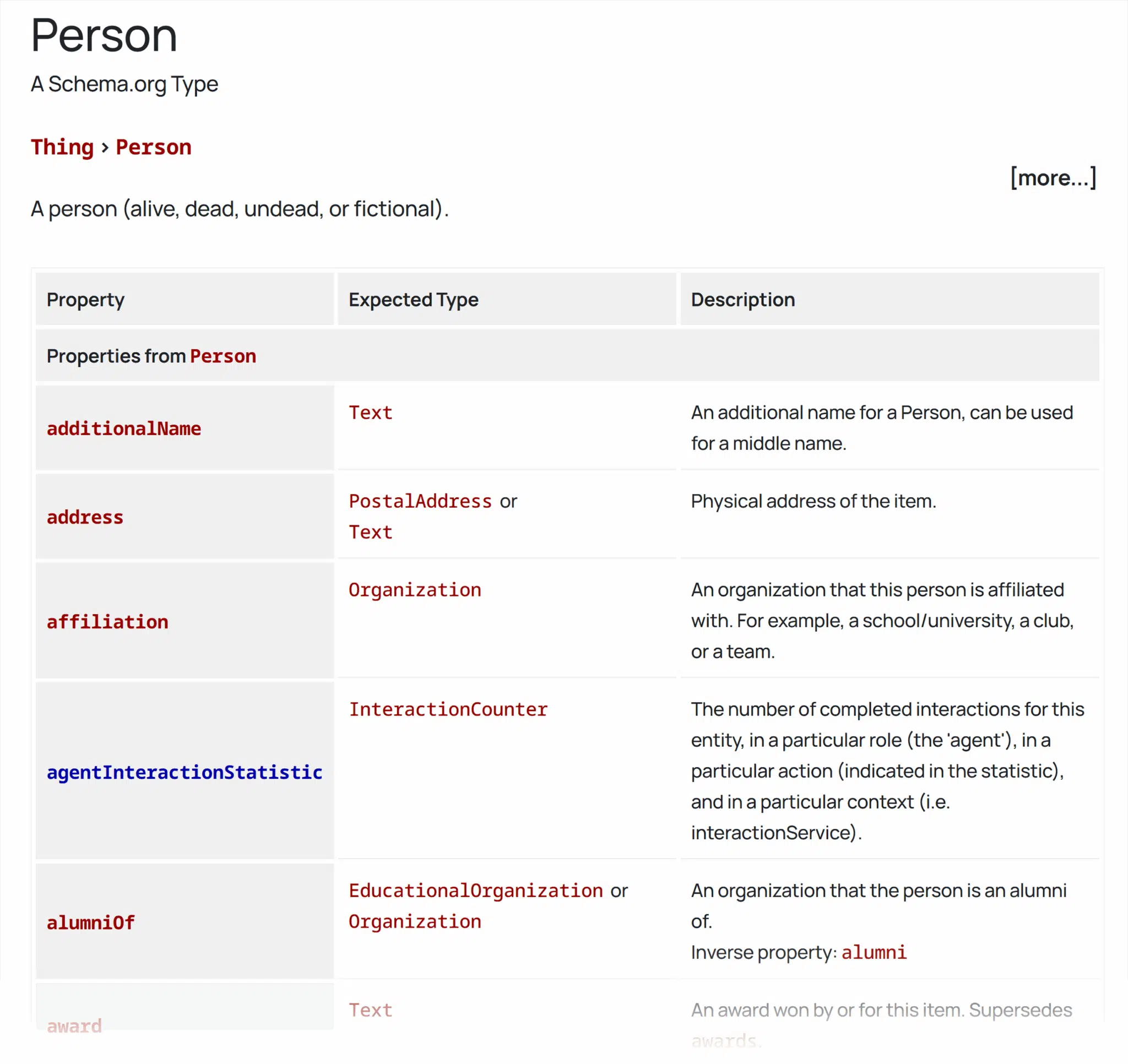
Listed in the properties column are all the options below within Person Type. For B2B, many properties help you build E-E-A-T for the Person Type. For example, you might add:
- affiliation
- brand
- hasCertification
- hasCredential
- hasOccupation
The best thing to do is review the properties available under Person and see what’s most suitable for your application.
Pro tip: sameAs is a great addition to structured data in B2B. Most professionals are mentioned in relevant and authoritative sites or use social media profiles professionally. Use sameAs to connect these entities because it helps confirm the person’s identity through association with trusted sources.
You can find the Organization schema type here.
What we know about structured data and AI-powered search
Google has confirmed that structured data is one of eight ways to be successful with AI search.
This provides some much-needed guidance for using structured data for AI visibility in Google’s AI.
The Search Central Blog says:
Make sure structured data matches the visible content
Structured data is useful for sharing information about your content in a machine-readable way that our systems consider and makes pages eligible for certain search features and rich results. If you’re using structured data, be sure to follow our guidelines, such as making sure that all the content in your markup is also visible on your web page and that you validate the structured data markup.
Like Google, Bing confirmed the use of schema markup as a reference check of their LLM training data. This insight was shared by Fabrice Canel, Principal Product Manager at Microsoft Bing, during his presentation at SMX – Search Marketing Expo in Munich. The insight was posted on LinkedIn by David Mihm, and Canel joined the discussion in the comments.

While Google and Bing have shared insights about structured data’s role in their AI experiences, we don’t currently have the same from other platforms like ChatGPT or Perplexity. This doesn’t mean that these tools aren’t using structured data, and it definitely doesn’t mean that they won’t. Simply put, we don’t know for sure how, or if, AI search tools like ChatGPT, Perplexity, and others use structured data and schema.
The benefits of structured data and schema are vast, so adding them to provide context to your web pages makes sense, regardless of the potential AI advantage.
If structured data and schema influence AI search outside of Google, great!
Conversely, if AI searches do not use structured data and schema to influence AI visibility, adding schema to your site would still be a huge benefit in many other ways.
The challenge of scaling structured data across enterprise sites
Structured data for B2B can feel incredibly complicated, and for that reason alone, it presents challenges. It’s hard to know what to ask for. Plus, developers and SEO teams might have quite a journey ahead as they learn about schema or structured data.
Just as you’re getting to grips with it, you realize that the challenges of structured data compound when you create new content at scale, or have hundreds—even thousands—of pages that all need structured data added.
The good news?
There is a solution for every challenge, which we’re addressing next.
Where to start with structured data
It’s easy to get overwhelmed by schema. There are numerous options for types and properties; not all will apply to you and your business.
The vocabulary currently consists of 816 Types, 1516 Properties 14 Datatypes, 94 Enumerations and 521 Enumeration members.
Many of them will be suitable for your site. Others won’t be.
If you add all suitable types and properties, you might get overwhelmed.
Best to start simple and manageable.
Here are some guidelines to help you decide what to add:
- Decide what you want to achieve with structured data. In the section above, we discussed the benefits of structured data, such as SERP features. If you want a particular SERP feature, such as your company’s star ratings, adding the structured data that will get you there makes sense.
- Consider structured data that can be automated. The beauty of structured data is that it can be automated so that particular pages always include structured data based on fields and the content on the page. Talk to developers about what can be easily automated and start with that. Automating schema makes adding different types of schema at scale easier and helps maintain accuracy compared to manually adding it. If you’re not working with developers, check your content management system (CMS) and its options for schema automation using plugins. We discuss plugins, including their pros and cons, in detail below.
- Lay the foundations of structured data by starting with your organization details and the Organization Type. Select properties that make sense to you and that you can easily find data for.
- Prioritize your most important pages. Usually, the pages you want to bolster the most are product and service pages. Ultimately, these pages drive revenue, so giving them the best chance of performing in Google and earning SERP features makes sense.
- Use common sense. With the number of types and properties available, common sense goes a long way in deciding what to implement. You’re better off starting small with what makes the most sense, then expanding on the schema later.
Over-reliance on AI
AI can produce schema for you, which can be very helpful and save time, but don’t implement it without reviewing the AI’s output with a professional. AI often gets the schema wrong.
Here’s an example of a prompt to create schema for a B2B organization and the AI’s output:
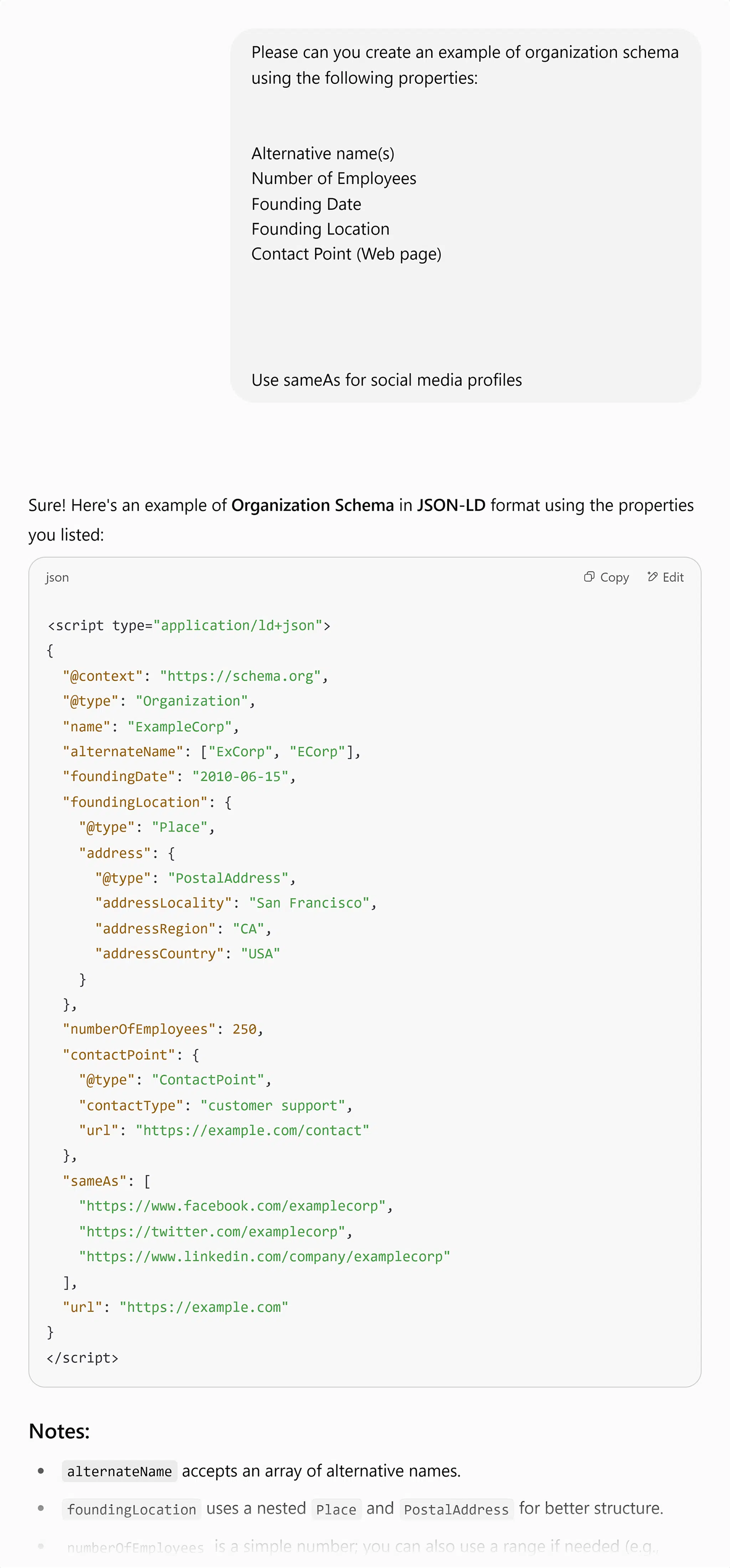
It’s helpful, but look out for:
- Hallucinations in the structured data: The AI will likely fill in details it doesn’t know; you must change them to be accurate.
- Incorrect application: Sometimes, AI tools mistakenly apply Properties (like name, author, price, etc.) to the wrong Types when generating schema markup, leading to invalid markup. Check everything against schema.org.
- Missed opportunities: These result because the AI hasn’t been comprehensive enough at assigning properties. You can check schema.org and ask the AI to include specific properties for optimal output.
Important note: A technical SEO professional must review AI-generated structured data and schema to check that it’s correct. Don’t skip this step.
Managing multiple page templates with different schema needs
Websites often have different page templates for products, services, blog posts, whitepapers, about pages, and more. For complex B2B, multiple types of product pages or services with separate schema needs might even exist.
Managing schema at scale can become a problem without process or documentation. Automation and documentation will help resolve this challenge. Both are covered in detail below.
New content that also needs schema
If you’re taking your structured data seriously, you should add schema to every new piece of content that is published.
Schema implementation can easily be missed or inconsistent if multiple people upload website content.
Integrating B2B schema requirements into content workflows is key. Use automation wherever possible, and establish clear rules for which templates need which types of structured data.
Important note: Because schema is code, it often falls within the developer’s remit, and to some extent, that’s fine. But it shouldn’t be seen as solely a developer’s responsibility. Train everyone involved in the content process on what structured data is, why it matters, and how they contribute to its correct and consistent use.
Coordinating between SEO, development, and content teams
Structured data sits at the intersection of three core teams or skills:
- SEO strategy
- Development and coding
- Content creation and publishing
All three have a role in maintaining schema across a site, particularly on enterprise websites.
The best approach is to enhance communication across teams by helping individuals understand their role in the schema process and creating standard operating procedures (SOPs) and workflows that prompt people to undertake the necessary tasks.
Tips for aligning teams and creating SOPs:
- Training upskills individuals so they understand their role in implementing the correct schema. Knowing why schema is essential and what to do makes them more likely to engage and care.
- Create workflows that include all necessary steps. For example, if a particular field on a CMS needs to be filled out to populate the schema, highlight this on a workflow so those uploading the content don’t forget to do it.
- Have one SOP per page template and make sure it’s accessible to all teams. Cloud-based documents, such as Google Sheets or Microsoft Word, are ideal as they can be easily accessed and edited.
Automating structured data at scale in B2B with tools and platforms
Automation solves many problems when it comes to schema and structured data.
Here’s how to use automations and tools to make structured data creation, implementation, and deployment a breeze.
Enterprise SEO platforms: Automate B2B schema analysis to maintain accuracy
Maintaining accuracy when using structured data at scale on B2B websites would be impossible without the proper tools. You won’t have the time (or the desire) to manually check every page with a structured data testing tool.
Instead, you can rely on tools that monitor and inform you about where there are schema issues.
Many tools can do this with varying levels of ease. In this article, we’ll demonstrate how you can use Semrush for this purpose because it:
- Is very easy to set up
- Sends warnings directly to your inbox so you don’t have to check anything manually
- Offers a comprehensive analysis of all schema across the site
- Automates schema validation and quality assurance across thousands of URLs
You can also use Google Search Console (GSC) to validate your schema and identify issues. It’s free, but you need to run checks manually, and GSC will only show you some of the schema on your site.
Here’s how to identify all schema issues and use the automated email report to streamline processes.
The Site Audit Report highlights invalid structured data.
Here’s how to access this information.
Open Semrush > click “Site Audit” in the left-hand menu > click “Create Project” at the top right.

Enter your domain name > optionally provide a project name (the website name works well) > click “Create project.”
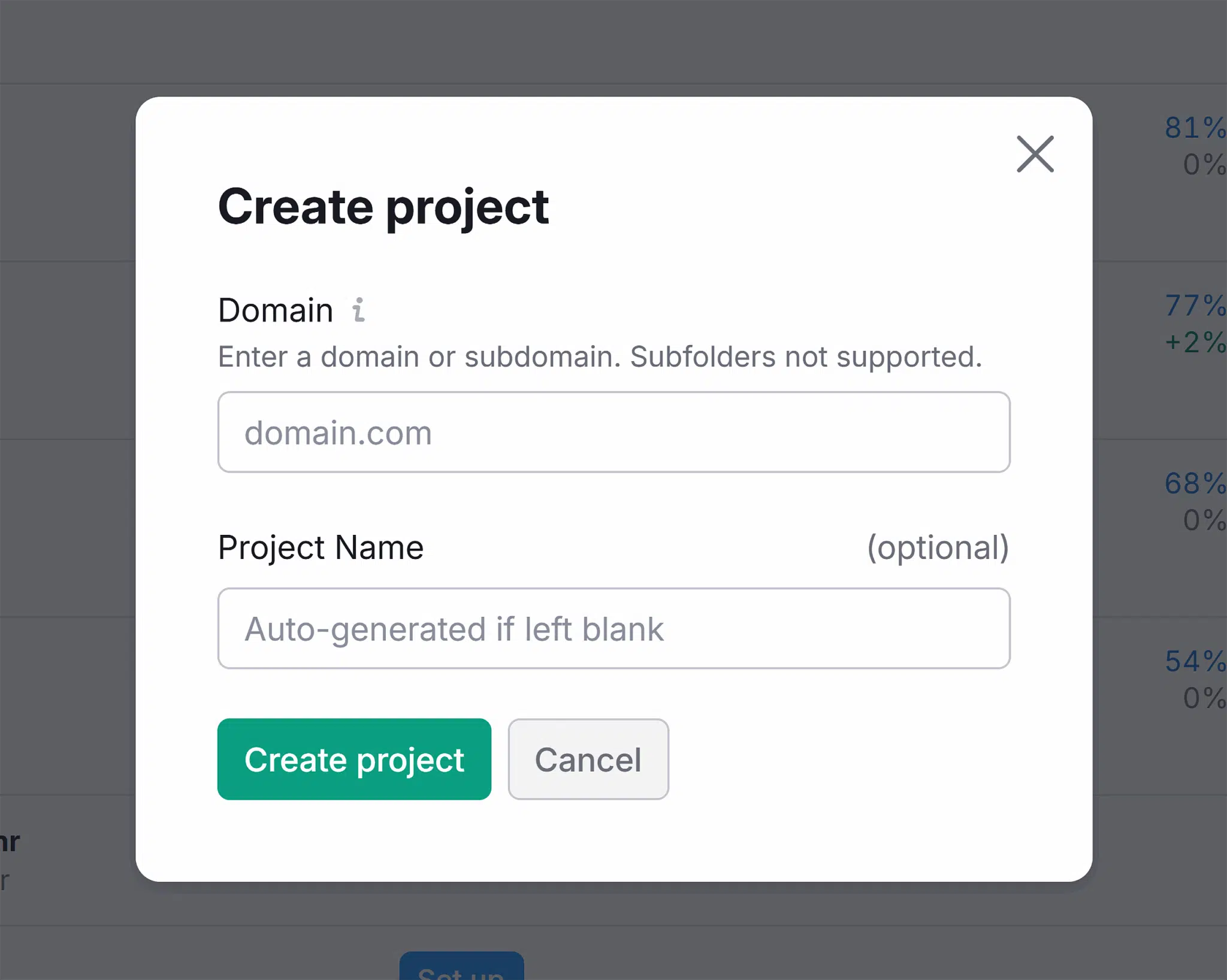
Set up your site audit. You don’t need to do anything special to crawl the site and identify structured data issues.
In the general settings, set the “Limit per audit” to at least as many pages as there are on your site. If you limit pages to less than this, the audit won’t run for every page on your site, so the data will be incomplete.
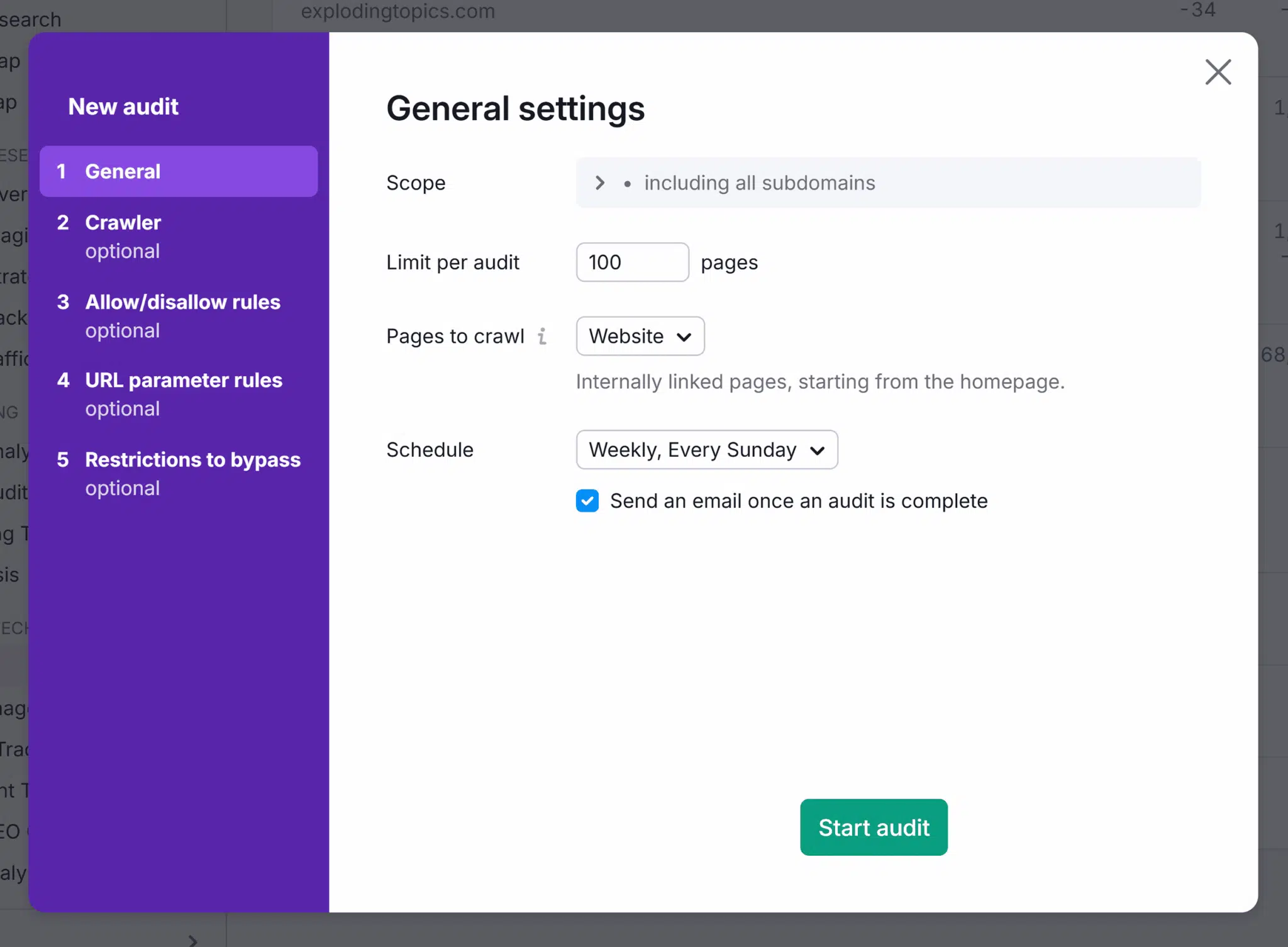
Depending on the size of your site, you’ll need to give the audit time to compile.
Once finished, you can review issues, including structured data issues.
In the left-hand menu, click “Site Audit” > click the project you want to review > Markup > “View details.”
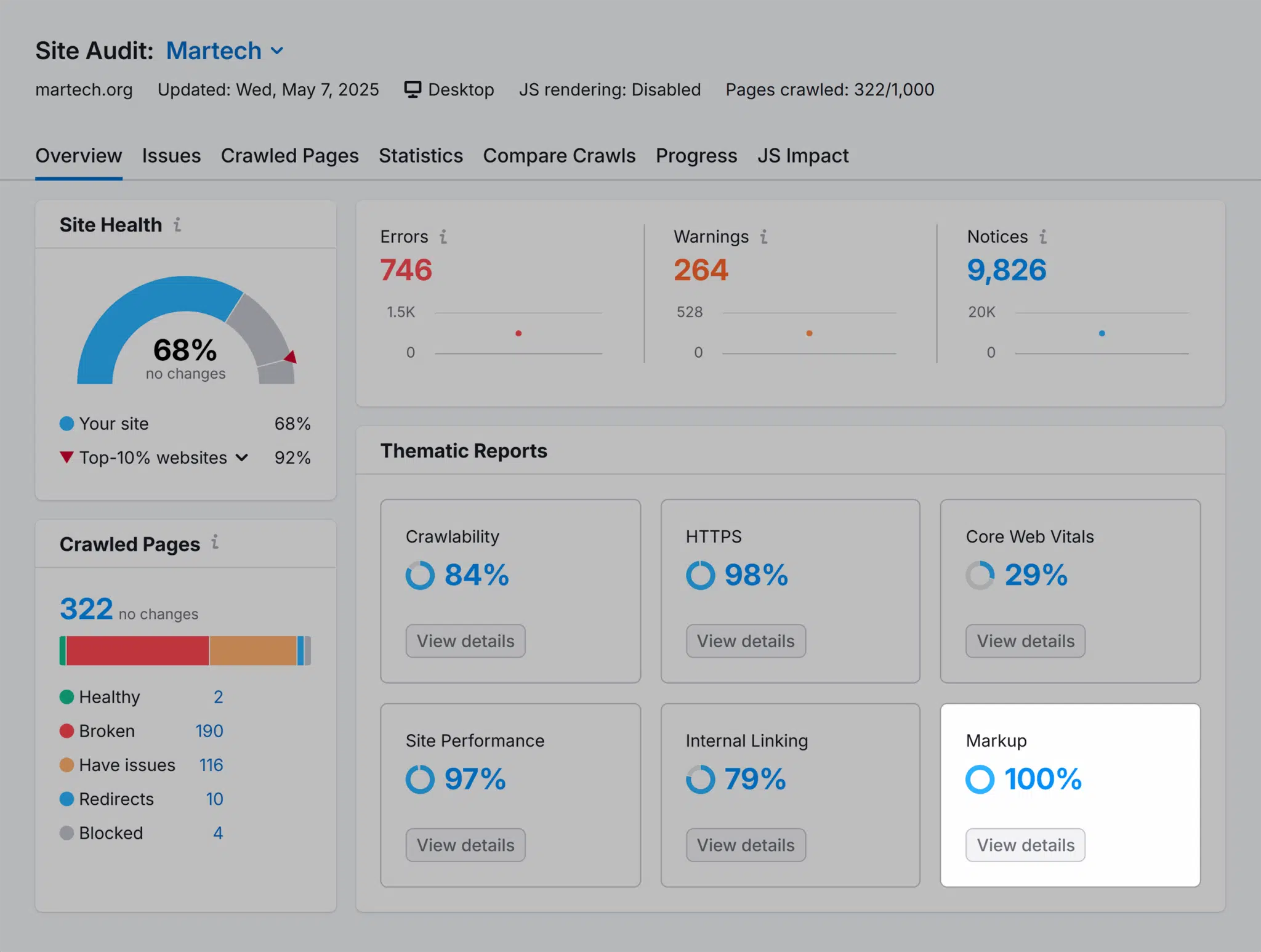
On the next page, click “View all invalid items.”
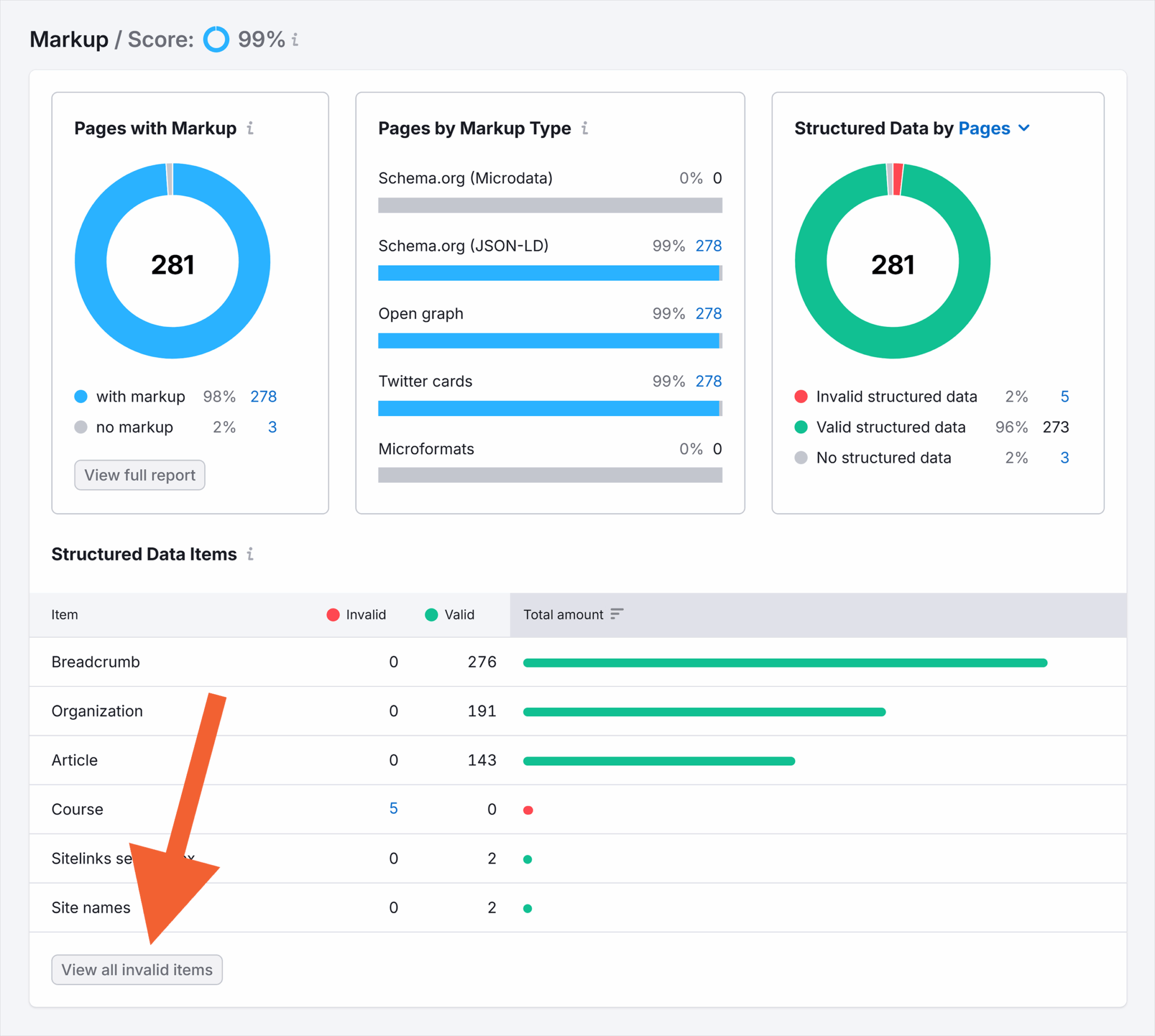
You will now see the “[X] structured data items are invalid” report.
This report includes:
- Page URL: Pages where there are structured data issues
- Structured Data Type: The type of invalid structured data (so you know what to look for when fixing it)
- Affected Fields: The exact field with invalid data
- Discovered: When the crawler first identified the issue
If you’re not sure how to resolve the issues, click on the “Why and how to fix it” tooltip, which provides more information.
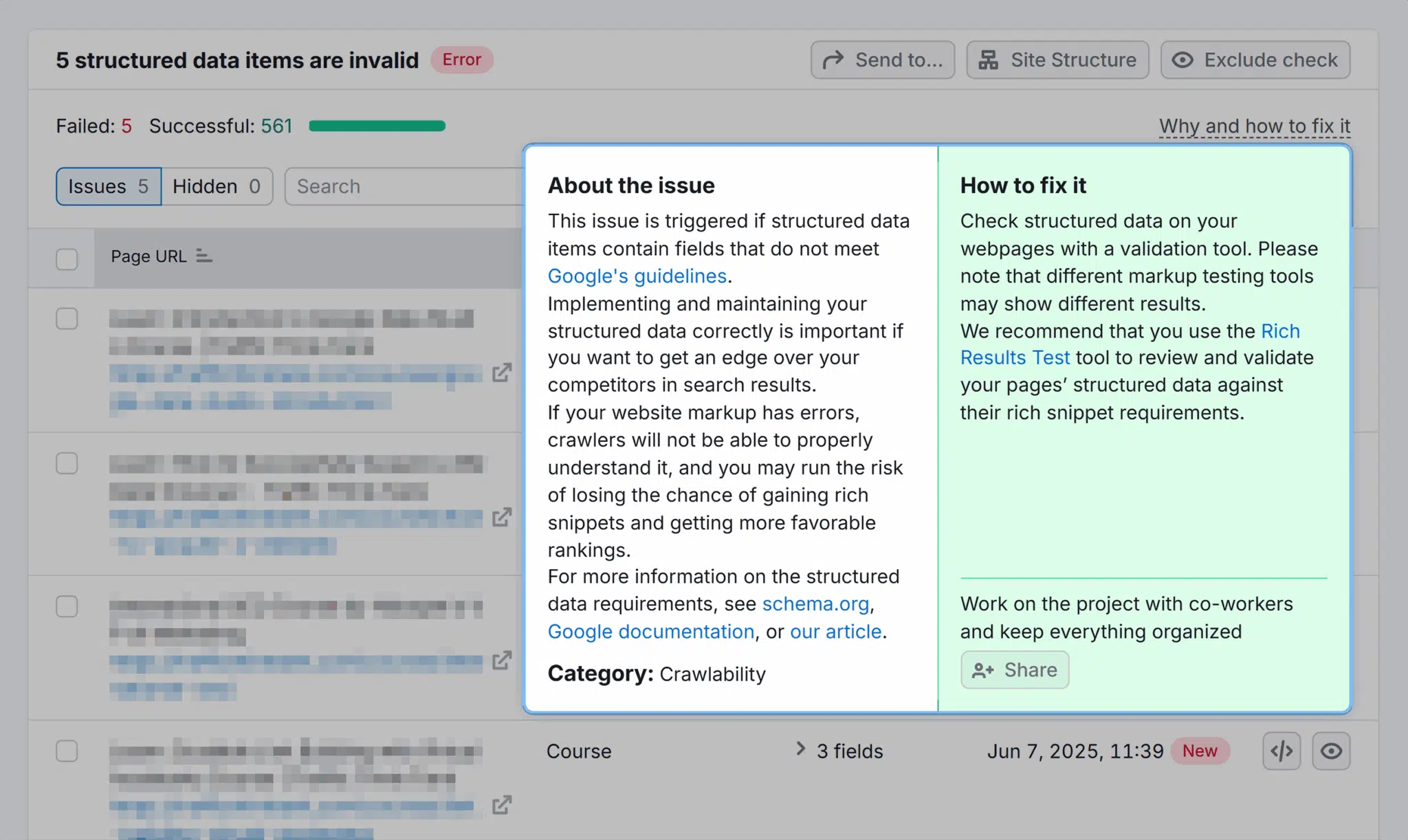
You don’t need to check this report manually. The software can email it to you or the recipients of your choice as often as you like.
Click “PDF” in the top right of the “[X] structured data items are invalid” report.
You’ll see a pop-up as pictured below.
Toggle “Email PDF report” and “Schedule report.”
You can add recipients and alter the main body of the email. You can also choose the frequency of the scheduled report.

Important note: The workflow described above only works if your site currently has structured data errors. If your site currently has no structured data errors and you still want to automate this report, you can set it up by following the workflow below:
Click “Site Audit” in the left-hand side bar > select your project > “Issues” > find and click on “[X] structured data items are invalid” under “Errors” > select “PDF” and follow the PDF workflow detailed directly above.
Pro tip: With Semrush Enterprise, you can streamline SEO workflows and A/B split tests, optimize content, automate link recommendations, and more.
Wix Dominated ‘How to Start a Blog’ Keyword for 2+ Years Using Semrush
✓ Find high-volume keywords you can actually win
✓ See which content deserves strategic schema markup
✓ Identify quick-win featured snippet opportunities
Free instant insights.
CMS-integrated solutions
Options for automating schema can likely be found in your website CMS, which your developers and SEO team should explore.
WordPress is a popular CMS, with 43% of websites using the platform. Many plugins, such as Yoast and Rankmath, make schema implementation easy. However, you must pick only one plugin to implement schema; otherwise, you’ll end up with duplicate schema, and things will get messy. Weigh all plugin options and pick the best one for your SEO needs.
Further reading: Yoast’s Guide to Implementing Schema with Yoast’s Plugin or Configuring “Schema Markup” in Rank Math for Rich Snippets
Pros of plugins and CMS-integrated solutions for B2B structured data:
- It’s a user-friendly setup for people of all levels—no developers are needed. It’s also a good foundation for schema and structured data setup.
- Automated solutions make it so you don’t have to think about the setup once it’s done. Plus, the implementation will be consistent and unlikely to go wrong.
Cons of plugins and CMS-integrated solutions for B2B structured data:
- Generally, customization is limited. You’ll likely be restricted to predefined schema types and fields. If you’re serious about schema, you’ll want to explore a custom code solution.
- The risk of duplication must be addressed if multiple plugins are installed.
Headless CMS solutions
Headless CMS options are generally highly customizable, and developers can support the structured data process using fields within page templates that automatically populate the schema. You can define your content types, such as product page, service page, or blog. Then, structured data can be automatically added.
For example, if you define a page as a “Blog Post,” fields like the ones below can be displayed within the CMS user interface and mapped directly to the BlogPosting schema with headline, author, and datePublished properties:
- Title
- Author
- Publish Date
Pro tip: Get as organized as possible if a developer integrates a schema system on a headless CMS. Ideally, developers will know precisely what schema types and properties are being used so they can build everything you need.
Pros of headless CMS solutions for B2B structured data:
- This is a highly customizable solution because developers can tailor the templates to meet your exact structured data requirements.
- Automatic population occurs once setup is complete. Page templates will populate from assigned content fields as long as those who upload content in the future follow the workflow and include the data where required.
Cons of headless CMS solutions for B2B structured data:
- A developer is required, although you can organize the setup as part of a one-off project.
- You must be organized before developer implementation and clear on what schema you want to populate.
Schema implementation without developers: Google Tag Manager (GTM)
Implementing schema and structured data doesn’t require a developer. You can use tag management systems like Google Tag Manager.
Pros of using Google Tag Manager for B2B structured data:
- No developer is required. You can set up schema independently, which is great for lean teams or when developers either aren’t available or are too busy.
- Deployment is fast because structured data can be added without waiting for developers.
- Experimentation is encouraged because SEO teams can test the likelihood of achieving a SERP feature on individual deployments. They can then ask developers to implement the schema more fully across the site, knowing it will get results. This helps get buy-in from teams or budgets.
Cons of using Google Tag Manager for B2B structured data:
From a practical point of view, Google representative John Mueller has previously cautioned against using GTM for structured data as a long-term solution.
Here’s what Mueller said:
From a practical point of view, I prefer to have the structured data directly on the page or directly on your server, so that you know exactly what is happening.
It makes it a little bit easier to debug things, it makes it easier to test things. So trying it out with Tag Manager from my point of view, I think is perfectly legitimate, it’s an easy way to try things out. But for the long run, I would try to make sure that your structured data is on your site directly, just to make sure that it’s easier to process for anyone who comes by to process your structured data. And it’s easier for you to track and debug and maintain over time as well, so that you don’t have to check all of these different separate sources.
Dedicated schema management platforms
For enterprise SEO, you can use dedicated schema management platforms like Schema App or WordLift to manage schema at scale.
Schema App is a particularly good tool because it integrates with any website.
Similar to the Headless CMS solutions, you create templates for different page types, such as a blog post. You add types and properties within the blog template by assigning the property to the relevant section.
The image below shows how Schema App assigns properties to elements on a blog post.
First, the element, the heading, is highlighted. Then, the property (headline) is applied in the right-hand sidebar.
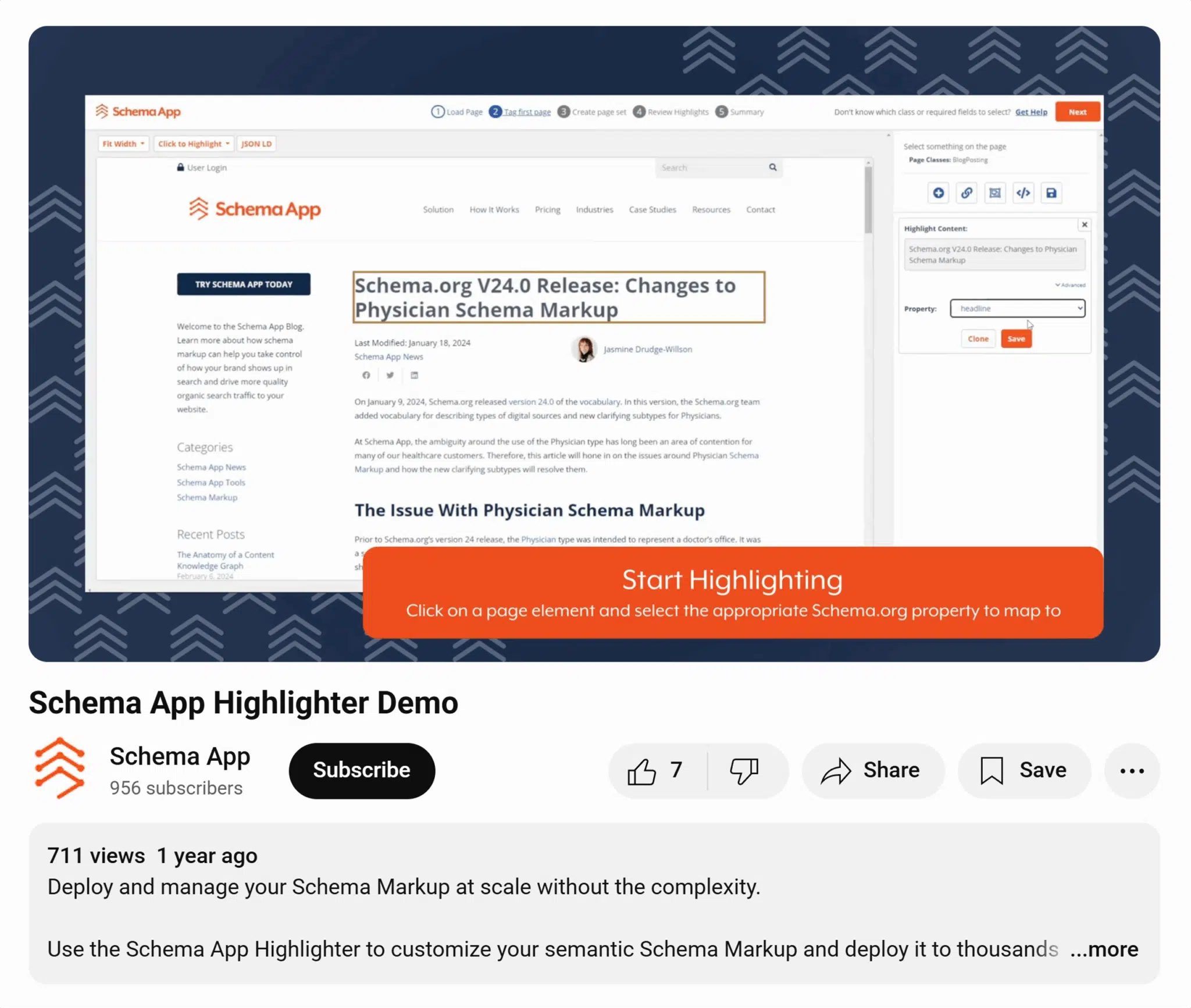
Pros of dedicated schema management platforms for B2B structured data:
- Templates are set so there’s consistency.
- The dedicated platform provides a central place for schema management, which helps organize schema tasks.
- You don’t need a developer because the schema is added using drop-downs and highlighting elements, as demonstrated in the image above.
Cons of dedicated schema management platforms for B2B structured data:
- The associated monthly or annual fees can be a downside.
- Teams must be trained to use the tool to get the best output. The tool does rely on correct implementation.
Governance and validation best practices
You need robust systems, schema, and structured data rules, as well as accountability, if you want to manage schema across a website— especially enterprise websites with a lot of pages.
Here are some best practices:
Automate the schema as much as possible
Previously, we mentioned automating schema and structured data with website plugins or headless CMS options where developers can assign fields that automatically populate structured data. The more automations you have in place, the more likely the structured data will be correct because this eliminates human error.
If you have a price update, for example, and you change the price field in a CMS, and that field auto-populates the schema, that one change keeps the price consistent across digital platforms. The last thing you want is to update a product, then forget to edit the code to change the schema, resulting in one price on search engine results pages (SERPs) and another on your website.
Create schema policies and workflows
Define the schema types used on your website and the pages they’re used on. This is especially important if the schema is auto-populated because you want everyone to use it correctly.
Consider:
- Defining your schema types and required properties
- Which page types have which schema
- Which fields need to be completed when uploading content
This central resource will encourage consistency and alignment across all teams, including SEO, developers, content, and website administrators.
Use version control on your website
Version control allows you to roll back changes on your website. Often, you can also see who made changes, as well.
If the schema and structured data are edited, but you decide you want to take it back to a previous version, you can do so in a few clicks with version control.
There’s nothing worse than editing schema to find the edit lost SERP features. With version control, you can reinstate the original schema that secured those SERP features originally. All being well, a rollback will resecure those SERP features.
Validate your schema efforts without needing a developer
One of the best things about schema and structured data is that you don’t have to make any guesses about whether things are implemented correctly. And you don’t need to be a developer to check it, either.
There are two main ways to validate schema, depending on what you want to achieve. If you want to secure rich results (like rating stars) in Google, then you can use Google’s Rich Results test tool.
Or, if you want to check that the schema is correct, there’s the schema validation tool from Schema.org.
What’s the difference between the two tools?
- The rich results test tool reviews only the schema that might help you secure rich results, like rating stars and prices.
- The schema validator tool reviews all schema.
Schema validation with Google’s Rich Results Test
You can use Google’s Rich Results Test tool to check if a URL is eligible for rich results. You can also use this tool to troubleshoot issues.
Go to Google’s Rich Results Test tool > Enter your domain > “Test URL.”
The tool will take a moment to test the URL. Once done, you’ll see a list of valid or invalid items.
The screenshot below uses our website as an example, and you can see that Martech’s schema is valid, and the Breadcrumb schema has been detected and is correct.

If your schema had errors, you’d see a screenshot like the one below. You can click into invalid items and explore the issues.

Schema validation with Schema Markup Validator
Schema Markup Validator is a tool that reviews the schema on a page of a website. The schema may or may not be related to rich results.
Go to Schema Markup Validator > Click “Run new test” > Add your URL > Click “Run test.”
The validator will return the code on your site and any schema. On the right, you’ll see errors and warnings. Errors and warnings should always be zero. If they’re not, the issues need to be resolved.
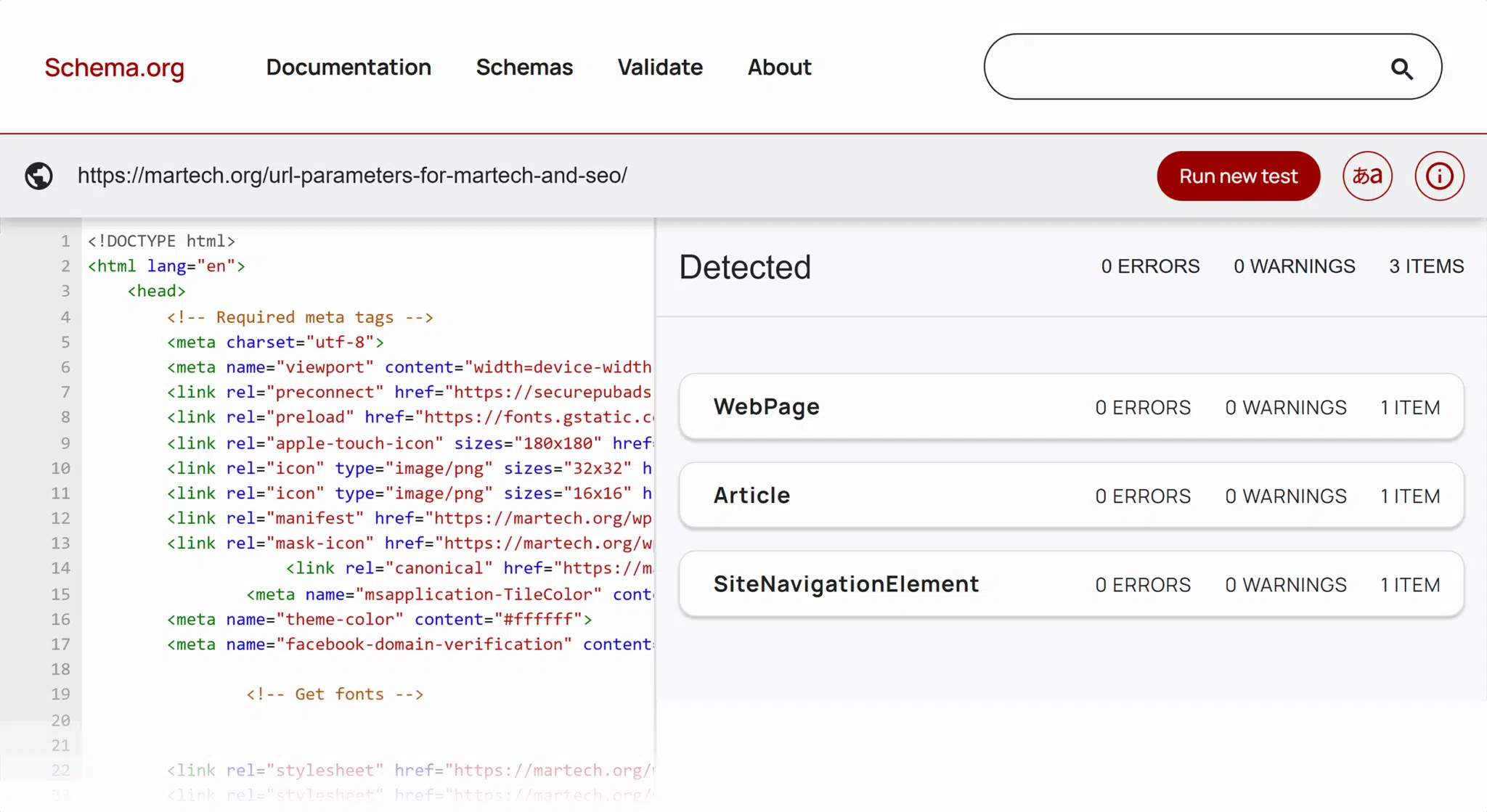
Pro tip: Use the schema markup validator to test code snippets. It’s especially useful if you’re manually adding schema as a test, or generating schema using AI, and want to alleviate the work for developers.
When you run a new test, select “Code snippet” instead of “Fetch URL,” paste your code, and the tool will validate the schema for you. If it’s correct, it can go onto the website. If it’s not, you might need some developer support.
Automating schema validation
While Google’s Rich Results Test tool and Schema Markup Validator are excellent tools, they rely on someone manually testing the schema.
With crawling tools like Sitebulb and Screaming Frog, you can automate crawls that include schema validation.
Further reading: Structured data testing using Screaming Frog or Automating schema structured data on Sitebulb
Future outlook: Schema in the era of AI and search evolution
While it might feel as though structured data is new, it’s actually stood the test of time and is unlikely to go anywhere anytime soon. Wherever data needs to be efficiently accessed and “understood” by software and humans, you’ll find structured data.
We know structured data is used for Google rankings, rich snippets, and at least some search engine AI experiences.
Although we don’t know how AI search tools like ChatGPT use schema markup and structured data, there’s a chance structured data plays a role already or will in the future. Plus, we know that tools like ChatGPT can search the web, and if you’re ranking well on Google and appearing in AI overviews, there’s a chance these tools will cite you.
If this article inspires you and you want more details about B2B schema, read: Why schema markup matters for B2B.
If you’re unsure if you’re using schema correctly (or even at all), get started with Semrush. You can start for free, and a trial will be enough to set up a site audit, check for schema issues, and see exactly where and how you’re using schema.
New on MarTech